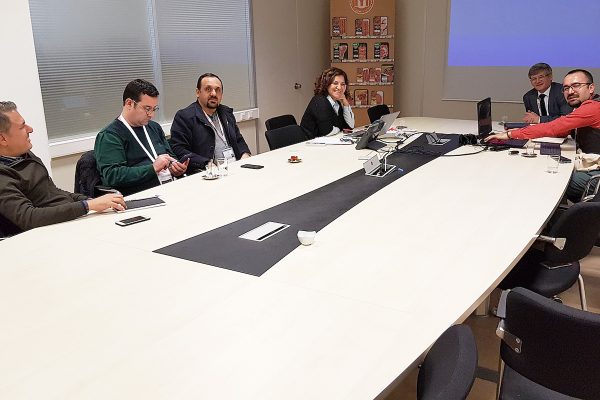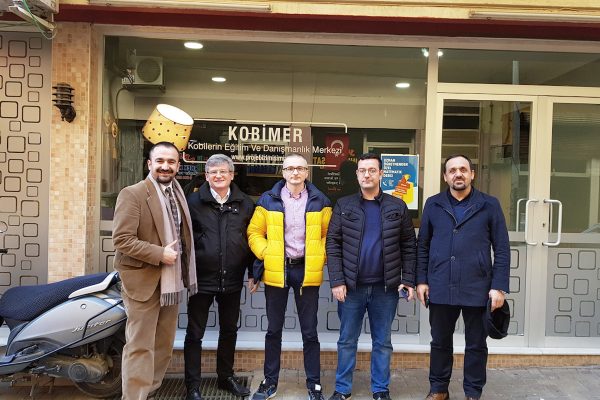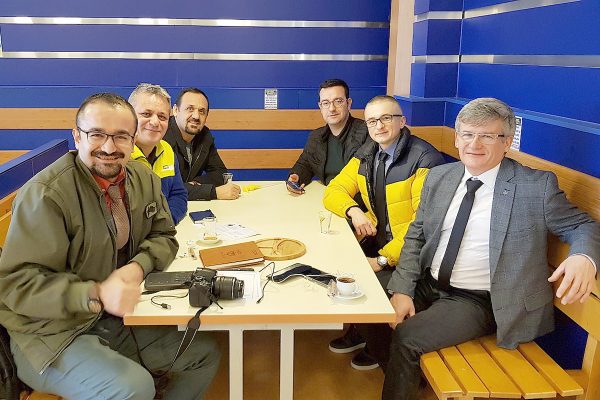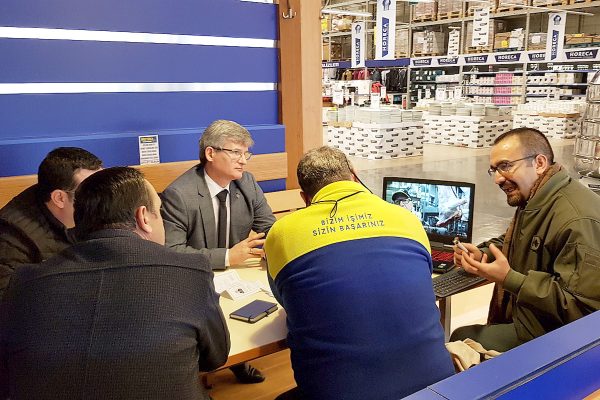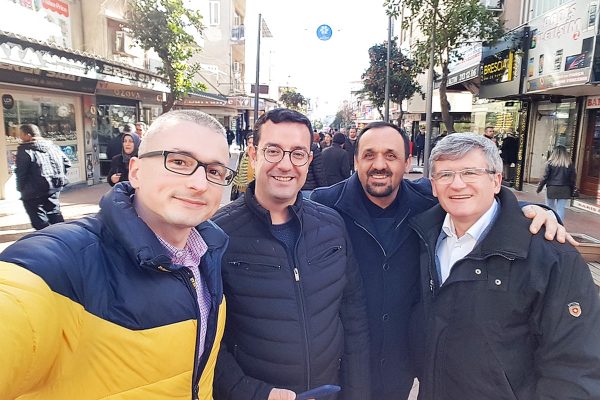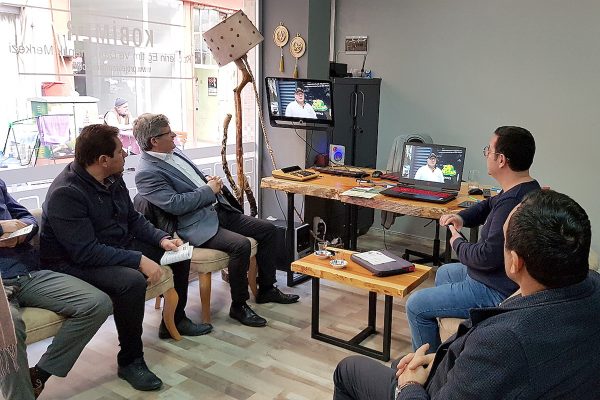In February 2020 BlueVent air systems Sp. z o.o. intends to participate in the individual economic mission and in the AGROEXPO fair, both events will be carried out in Turkey, i.e. on the target market - promising for BlueVent air systems.
source: http://wikp.udsc.gov.pl/kraje-pochodzenia/turcja.html, Turcja, Bożena Siekierska.

Turkey is a country spread on two continents (it is mainly located in Asia and in a modest 3% of its area in Europe), connected by bridges over the Bosphorus in Istanbul. A country extremely diversified in terms of geography, culture, with a history that goes back a long way. Turkey is an extremely diverse country, with an area of approx. 780 thousand. km². It stretches over 2,000 km (distance from Edirne - d. Adrianopol - on the northwestern edge of Turkey to Hakkari - on the southeastern edge). Somewhat similar in shape to the rectangle, Turkey, on three sides it is covered with seas: in the north - by the Black Sea, in north-west Europe is separated from Asia by the Sea of Marmara with the Bosphorus (to the Black Sea) and Dardanelles (to the Aegean Sea), in the west - Aegean and in the south - the Mediterranean. Behind its eastern and southern land border, Turkey has as its neighbors: (from the north) Georgia, Armenia, Iran, Iraq and Syria.
Turkish landscapes are amazing: mountains entering the sea or the eroded rocky mushrooms of Cappadocia. Mountain peaks are located on the Black Sea, Aegean and Mediterranean. One of the peaks near Antalya reaches a height of 2365 m a.s.l. It is said that in Turkey, in one area of the country, on the same day you can go skiing and take a bath in the sea. While in the summer the Mediterranean coast is scorched by the sun, the Pontic Mountains on the Black Sea tempt with greenery and cold.
People and their culture
The population of Turkey is over 76 million citizens, including about 14 million in Istanbul alone. Turkey is inhabited by: Kurds (9-17 million - such a discrepancy results from the approach to the Kurdish issue and assumptions made in the study), Arabs (approx. 8 million, including in cities bordering with Syria even more than 40% of the population), Georgians (approx. 1 million in the eastern part of the Black Sea coast), Roma population (in total over 400,000, the vast majority live in Thrace and the vicinity of the Marmara Sea coast), Armenians (in Istanbul and in the east of the country about 100,000, live under enormous pressure from the majority of Muslims), Jews (about 20,000), Greeks (1923-24, under the Lausanne Treaty, an exchange of population between Turkey and Greece took place: 1.2 million Greeks were forced to leave the Aegean region and Black and Thrace, and 500,000 Turks left Greece; currently a handful of old Greeks live in Turkey, no more than 4,000).
Users of the Altaic language group, from which the modern Turkish language grows, speak languages with a similar (basic) word resource, structure based on the suffix principle and specific vowel harmony. In addition to Turkish, the Turkic subfamily includes Azerbaijani, Turkmen, Uzbek, Tatar, Kazakh, Tuvinian, Altai and Kyrgyz. Kurds speak languages from the group of Iranian languages, in Turkey - North Kurdish dialect (Kurmandi). The second dialect - sorani - is used by Kurds living in Iran, Iraq and Syria.
In Turkey, the tradition of telling oral stories is still alive. Aszyk (tur .: aşık) is a poet of the sazu, because he not only interprets the stories but also creates and improvises himself and often plays the saz (saz is a traditional 7-string plucked instrument). In 2009, the Bard tradition Aşıklık was inscribed on the UNESCO list of the intangible heritage of humanity.
Holidays and national customs
Islam is the dominant religion in Turkey. Most of the population are followers of Islam in the Sunni (orthodox) version, but about 6-8% of the population are Alevis (although the figures quoted by the Alevis only say about 20 million).
Fasting in Muslim countries lasts the entire one month - 29 or 30 days falling on the ninth month of the lunar Muslim calendar, Ramadan (tur: Ramazan). Every year, the Ramazan month, and thus fasting, moves forward eleven days. Fasting consists in the fact that from sunrise to sunset a healthy adult does not take anything in his mouth (drink, food, cigarette) and refrain from sexual intercourse. In summer, refusing a glass of chilled water in a clay jug is very difficult. In practice, it looks like before sunrise, groups of men walk on the streets of Turkish cities and drumming to wake people for breakfast, which should be completed by the dawn. In the evening there is increased traffic and queues in front of bakeries.
The fasting is followed by a three-day festival Ramazan Bayramı, also called Şeker Bayram. In Turkey, this holiday is three days off from work, it is a great opportunity for family gatherings. The whole country is on its way. At the last minute it is impossible to buy a ticket for public transport. Holidays between distant family members must be planned well in advance. Giant traffic jams are forming at the entrances to large cities, buses have hours of delays. It is a bit calmer in the villages. The most important element of preparation is making holiday sweets.
The most important festival of the entire Muslim world is Kurban Bayramı, the festival of sacrifices. Sunni is also called Hacılar Bayramı (tur: hacı - pilgrim) because it is to them that "all pious Muslims" head to the holy city of Mecca on pilgrimage to make their sacrifices there. In Turkey, interest in it is growing every year. There is not enough space for everyone who is interested and that is why draws are organized. The holiday lasts four days. Similarly to Şeker Bayram, also in this case people visit each other. The first thing you do on this occasion is to kiss the hands of respected, senior family members to express the love and significance that life wisdom has in the community. Best wishes: Bayram kutlu olsun! or Bayram mübarek olsun!, heard on all sides.
Everyone is in a joyous and cheerful mood. Usually on the first holiday day it is ritual (with prayers and blood, preferably straight to the ground), sacrificial animals (most often sheep or ram) are killed so that they can eat together with the guests. Meat should be shared with the poor. In the past, the holiday days was eagerly awaited, not only because there were a few days off from work and school, but also because the holiday days’ games had a special character. Currently, nothing from the atmosphere of past years has remained. One of the effects of youth migration to cities is the aging of rural areas. During the holidays, young people wandered or drove through the villages singing, hitting some hastily made instruments, trumpeting car horns. In the evenings in the villages there were dance parties.
In Turkey, where pride in being Turkish is widespread, public holidays are taken very seriously. Flags and banners with Atatürk images are displayed during public holidays. In remembrance of the 1922 victory over the England-backed Greeks, the feast of victory (Zafer Bayramı, August 30) is celebrated, for the first time on its first anniversary in Ankara, Afyon and Izmir.
April 23 is the festival of National Sovereignty and Children's Day (Ulusal Egemenlik ve Çocuk Bayramı) celebrated on the anniversary of the convocation of the first Parliament of the Turkish Republic in 1920.
Relations with Poland
The year 1414 is assumed as the moment of establishing diplomatic contacts between Poland and Turkey. Then King Władysław Jagiełło sent the first deputies (Skarbek from Góra and Grzegorz Armenian) to the Ottoman Sultan, to Bursa. The first document that has survived is the letter of Mehmed the Conqueror, sent two years after the capture of Istanbul in 1455, to the Wallachian voivode. In the fifteenth century, the Ottoman Empire very efficiently expanded its borders to enter direct border contact with the Polish-Lithuanian Jagiellonian state. In the sixteenth century, both countries had a similar goal: to stop the expansion of the Habsburg dynasty. The exchange of messages continued to strengthen contacts. The Victoria of Vienna (1683) of King Jan III Sobieski became a crack in the positive image of relations between the two countries. During the partitions, friendly Polish-Turkish relations were largely based on a sense of solidarity with common enemies. In the mid-nineteenth century, especially after the fall of the Hungarian uprising, Istanbul became a shelter for numerous Poles who gathered around Prince Adam Czartoryski.
Created on his initiative, the Central Agency of the Eastern Mission of the Hotel Lambert was marked by diplomatic representation. Thanks to his efforts, in 1842, not far from the Bosphorus, Polish emigrants (largely fugitives from the tsarist army) managed to establish the Polish settlement Adampol (tur .: Polonezköy, literally: Polish village), in which their descendants live to this day , still making efforts to cultivate Polish culture, tradition and language.
Probably the most famous Turkish, having a connection with Poland, was Nazım Hikmet Ran (born in 1901 in Thessaloniki, died in 1963 in Moscow), a poet, playwright with communist views. His mother was a granddaughter of Konstanty Borzęcki.
He was a participant in the Poznań Uprising of 1848 and the Hungarian Revolution of 1849, together with General Bem emigrated to Turkey, adopted Islam and the name of Mustafa Celaleddin Paşa and contributed a lot to the strategy of Turkish wars from 1852, promoted to the rank of general, author of the book "Les Turcs anciens et modernes" . Hikmet was repeatedly tried for communist activities, arrested several times, after one of the amnesty he escaped from Turkey, was deprived of Turkish citizenship (posthumously it was restored in 2009), he adopted Polish citizenship, but lived in Moscow. Many of his poems have been translated into Polish.
According to data from the Office for Foreigners, migrants from Asian countries, including Turkey, are arriving in Poland. At the end of 2012, 2.5 thousand had valid residence cards. Turków (in 2008 - 1.4 thousand). The Turkish migrations began in the 1960s with the signing of contracts for sending workers for seasonal work. The vast majority of employees came from small towns and cities or from the countryside.
Another wave of migration, from the 1980s, was associated with the socio-political situation in Turkey, i.e. the military coup and the growing Kurdish conflict. Migrants who came to our country took up almost exclusively business: textile trade, gastronomy and tourism. They have lived in Poland for many years, the vast majority married Polish women, which was often the most important reason for staying away from their homeland. In general, they constitute a relatively wealthy and well-educated group.
Along with the change in the political system in Poland, entrepreneurs from the tourist, gastronomy, textile and construction industries began to come in. The textile industry is still strongly represented in Wólka Kosowska, while construction workers (both highly qualified engineers and workers) have stayed and are staying in Poland in connection with conducting Turkish investments (e.g. Millennium Plaza, Blue City, construction of the II line of the Warsaw metro).
In connection with the Turkish influx to Poland, many bilateral legal acts have been signed since the early 1990s, including on legal assistance in criminal, civil and commercial matters, extradition, mutual support and protection of investments, cooperation in the fields of science, education and culture, and cooperation in combating terrorism and crime.
After Poland's accession to the EU (a large wave of migration of Polish citizens to EU countries), a new wave of migration from Turkey arrived - mostly entrepreneurs establishing companies in the hotel, catering and industrial sectors. The youngest group representing Turkish migration to Poland are students coming to our country (Warsaw and other major cities) under the Erasmus program.
Integration in Poland - successes and difficulties
The Association of Turkish Entrepreneurs in Poland POTIAD is very active in Warsaw. It associates approx. 130 active members and is in constant contact with approx. 300 companies. After the flood in 2007, the renovation of the School Complex No. 1 in Wrocław was supported - on June 2, 2008, with the participation of the city authorities, educational authorities and invited guests from Turkey, the Technical Secondary School No. 1 was named after Mustafa Kemal Atatürk. Every year, in April, as part of the Saint Patron Saint's celebration, the school organizes meetings with Turkish culture. The Association organizes events bringing together Turks: picnics, holiday meetings and April 23 as a day of Polish-Turkish friendship (National Day of Sovereignty and Children's Day, in Turkey a public holiday established by the founder of the Republic of Turkey to emphasize the importance of children as the future of the nation), as well as a street festival in In Warsaw.
In the eyes of the Turks themselves, Poland is a very friendly country for them. They usually pay attention to historical relationships full of mutual respect and sincere friendship. They consider Poles tolerant of strangers. They realize that for centuries Islamists - Tatars have lived in the Commonwealth.”
Turkey is for BlueVent air systems Sp. z o.o. an important area due to the significant amount of beef production in this country. According to the Polish Meat portal in 2016, there was an increase in beef production in Turkey by more than 15%: "The latest study of the Institute of Agricultural and Food Economics shows that in 2016 world beef production amounted to 60.5 million tonnes and was by 1, 2% higher than a year ago. An increase in production was recorded by almost all countries that were leaders in the production of this meat. The largest increase in year-on-year terms (2015 to 2016) was recorded in Turkey, in which production increased by 15.4%! In the United States, beef production increased by 6.3%, in China by 4.5%, in India by 2.4%, in Mexico by 1.6%, in Pakistan by 2.3%, and in the European Union by 2.8%. Australia recorded the largest decrease - by 16.6%.”
source: http://polskie-mieso.pl/wzrost-produkcji-wolowiny-turcji-o-ponad-15/
In the same year, information and press materials appeared about the increase in beef exports from Poland to Turkey:
„We will export more beef to Turkey (publication date 25.07.2016)
Three new Polish plants have been entered on the list of plants authorized to export beef, which is kept by the Ministry of Food, Agriculture and Livestock of the Republic of Turkey - the Ministry of Agriculture reports on its website.
The Turkish authorities provided the Chief Veterinary Inspectorate with beneficial information for producers interested in selling beef on the Turkish market - All enterprises inspected from June 29 to July 1 received an export permit.
So far, nine Polish beef producers have gained access to the Turkish market. To obtain permission to export their products, all producers had to undergo a three-time inspection by Turkish inspectors.”
source: https://www.tygodnik-rolniczy.pl/articles/pieniadze-i-prawo/bedziemy-eksportowac-wiecej-wolowiny-do-turcji/

„Turkey is opening to Polish beef exporters (publication date: July 26, 2016)
On the list of Polish plants authorized to export beef, which is kept by the Ministry of Food, Agriculture and Livestock of the Republic of Turkey, there are three new plants.
According to the Chief Veterinary Inspectorate, on July 22, 2016, the Turkish authorities informed about the results of the inspection carried out between June 29, 2016 - July 1, 2016 in Polish beef sector plants. All companies in which the inspection took place were allowed to export their products to the Turkish market.
As a result of three inspections taking place in our country over the past eleven months, nine Polish factories have already been authorized to export to the Turkish market.
In July 2016, the Chief Veterinary Inspectorate once again provided the Turkish side with a list of a dozen or so other entities interested in selling beef to the Turkish market and is waiting for the date of the next inspection.”
source: https://www.portalspozywczy.pl/mieso/wiadomosci/turcja-otwiera-sie-na-polskich-eksporterow-wolowiny,132485.html
„Beef from Poland will go to Turkey again (publication date:13.06.2016, updated:14.06.2016)
Turkey resumes shopping for Polish beef. This is good information for domestic producers of this meat, because the Turkish market is very absorbent. As TVP 1 informs, as a result of this decision it may soon turn out that Poland will lack meat cattle, both hybrid and pure breed.
Beef from Poland has also been desirable in Turkey since last week. The country is looking for good meat throughout the Community. According to TVP 1, according to estimates, there are about 350,000 tons missing on that market. That is why a visit of the Turkish delegation appeared in our country, which wanted to establish business contacts.
Polish beef is well known in Turkey. A few years ago, our country was the main supplier of this meat to the local market. Unfortunately, exports have been halted due to the outbreak of BSE in Europe, or bovine spongiform encephalopathy, popularly known as mad cow disease. However, we now have a chance to return to the Turkish market.
Ta sytuacja może napawać optymizmem polskich hodowców bydła mięsnego, którzy w najbliższym czasie spodziewają się podwyżek cen skupu. Oprócz popytu na wołowinę sprzyja mu także wysoki kurs Euro.”
source: https://www.agropolska.pl/produkcja-zwierzeca/bydlo/wolowina-z-polski-ponownie-trafi-do-turcji,499.html
In 2019 the situation has changed somewhat, however, regardless of the decline in beef exports to Turkey, the market is still important for BlueVent air systems, because beef production is mainly important in Turkey itself. The reduction of exports to Turkey is, according to press announcements, a temporary situation.
Imports of beef in Turkey serve as a measure against excessive inflation, which is why it is not sustainable. The only entity authorized to import beef is the Turkish Meat and Milk Council. The increase in beef prices in Turkey in 2017 and 2018 contributed to an increase in imports from the European Union, mainly from Poland. The level of inflation in Turkey since the 4th quarter 18 is very high (although with a decreasing tendency), nevertheless, a poor valuation of the lira may be a factor reducing the likelihood of rapid resumption of supplies, even at high beef prices in that country.
In addition to the decline in beef sales from Poland outside the EU, exports to the EU also decreased (in the first 4 months of 2019 by 6.5% per year). Considering that the decrease in sales to the Community countries began much earlier (in the second half of 2018 sales decreased by 11.3% year-on-year), the impact of the scandal with illegal slaughter of cattle in Poland in early 2019 on beef exports can be considered relatively small.
source: https://poradnikhandlowca.com.pl/artykuly/spadaja-ceny-wolowiny/
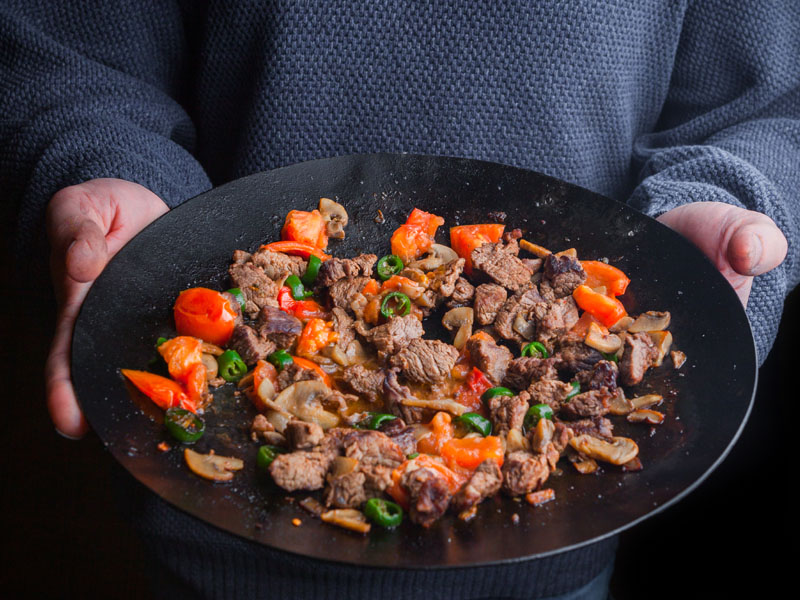
For gourmets of beef and Turkish specialties
Fried beef or kavurma
Below is the recipe, which we hope, will interest beef gourmets:
http://turcjaodkuchni.blogspot.com/2015/10/smazona-wolowina-czyli-kavurma.html
We recommend!
The mission was carried out in Turkey, in the cities of Izmir and Istanbul from February 10, till February 11, 2020
The purpose of the mission was to test the device for electrostimulation of beef carcasses (HVES) to confirm the usefulness of the device in the activities of potential Turkish partners before making their purchase.
Meetings with partners were held on February 10, and February 11, 2020 at their headquarters and in business areas - device tests were talked about and planned the meetings. Initial presentations ended quite positively.
A representative of the company www.taleres.tr, which is one of the main suppliers of BMS systems for dairy cow buildings in Turkey, organized a meeting with the company KOBIMER (business partner), which was interested in testing the device for electro stimulation of beef carcasses (HVES), to confirm the suitability of this device in the business partner's business before purchasing it. The meeting was organized on February 10, 2020 - during the meeting there was a presentation on how the device works (folders, films, presentation). KOBIMER representatives confirmed that they are interested in pointing to slaughterhouses in the vicinity of Izmir for testing. They also helped organize the next meetings on the same day and the next.
On February 11, 2020, a meeting was held with the person responsible for development and QA (R&D Manager, Food Engineer) at MIGROS, which has 2,000 stores in Turkey, including its own cutting lines.
The company measures meat color in its stores, leakage at various stages in stores and meat tenderness with professional equipment. This company is very interested in improving the color, reducing leakage, and improving fragility. It was the second meeting with this client.
This meeting was associated with an earlier presentation of the operation of the device in the slaughterhouse in Etcia in July 2019. This time the films were presented explaining the operation of the system. The client expressed a desire to carry out tests in a designated slaughterhouse in Turkey in March 2020.
Final tests should lead to the first transactions on the Turkish market.

